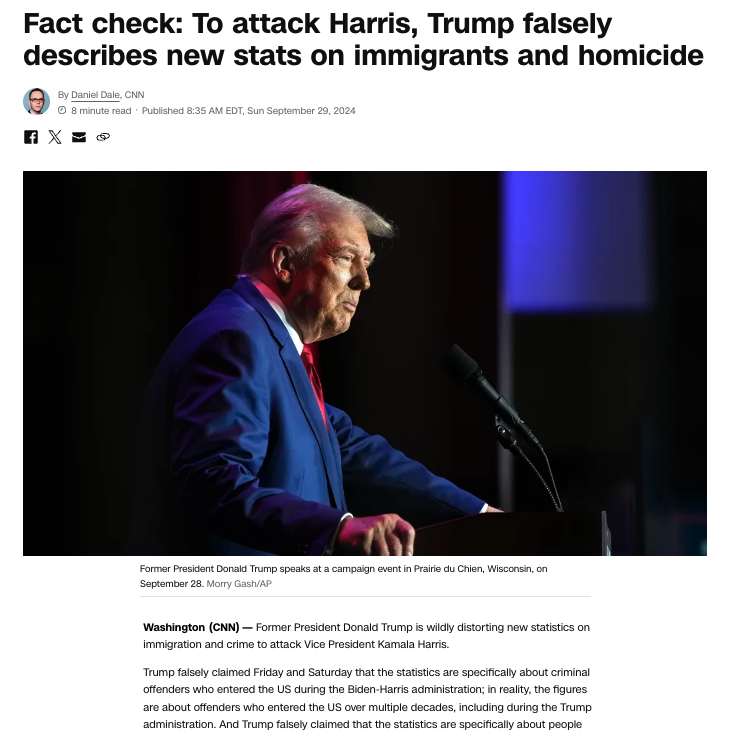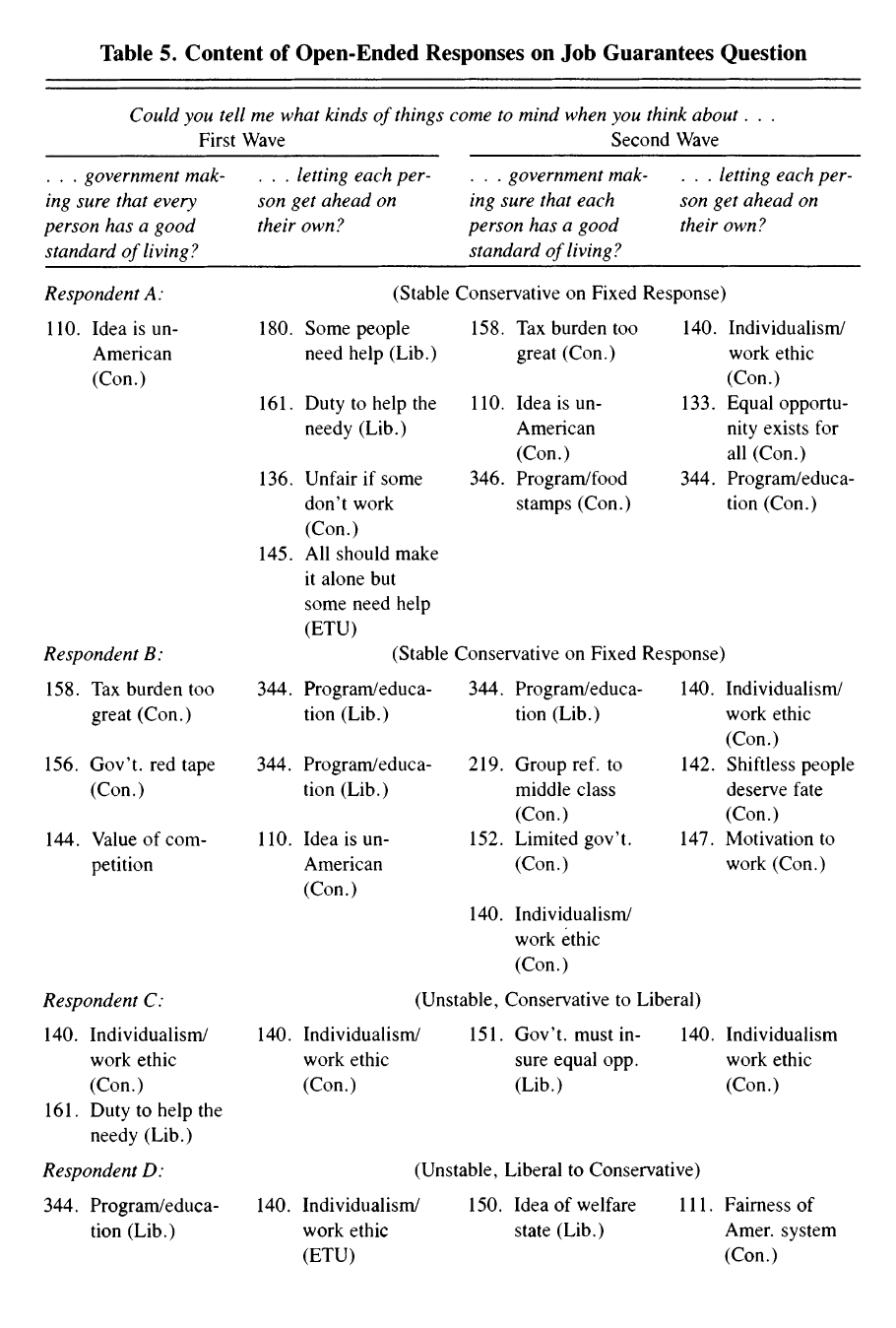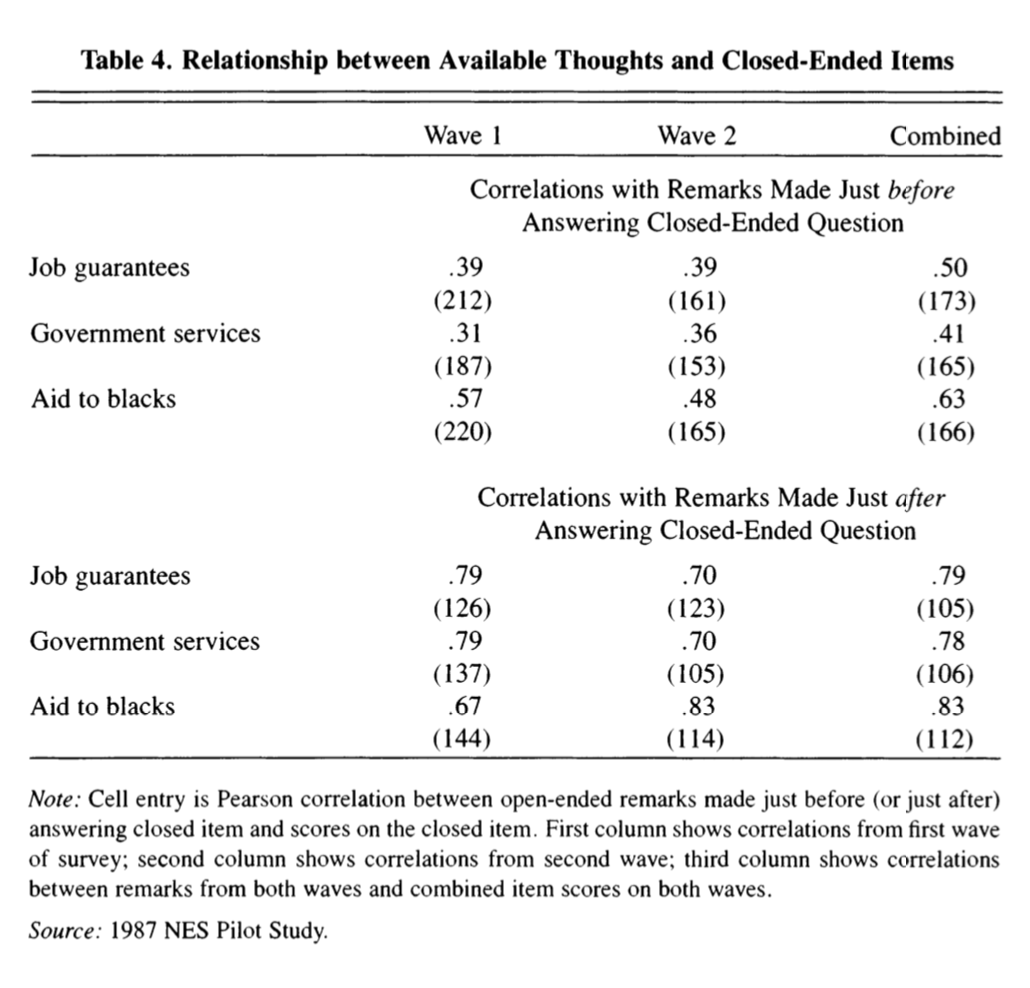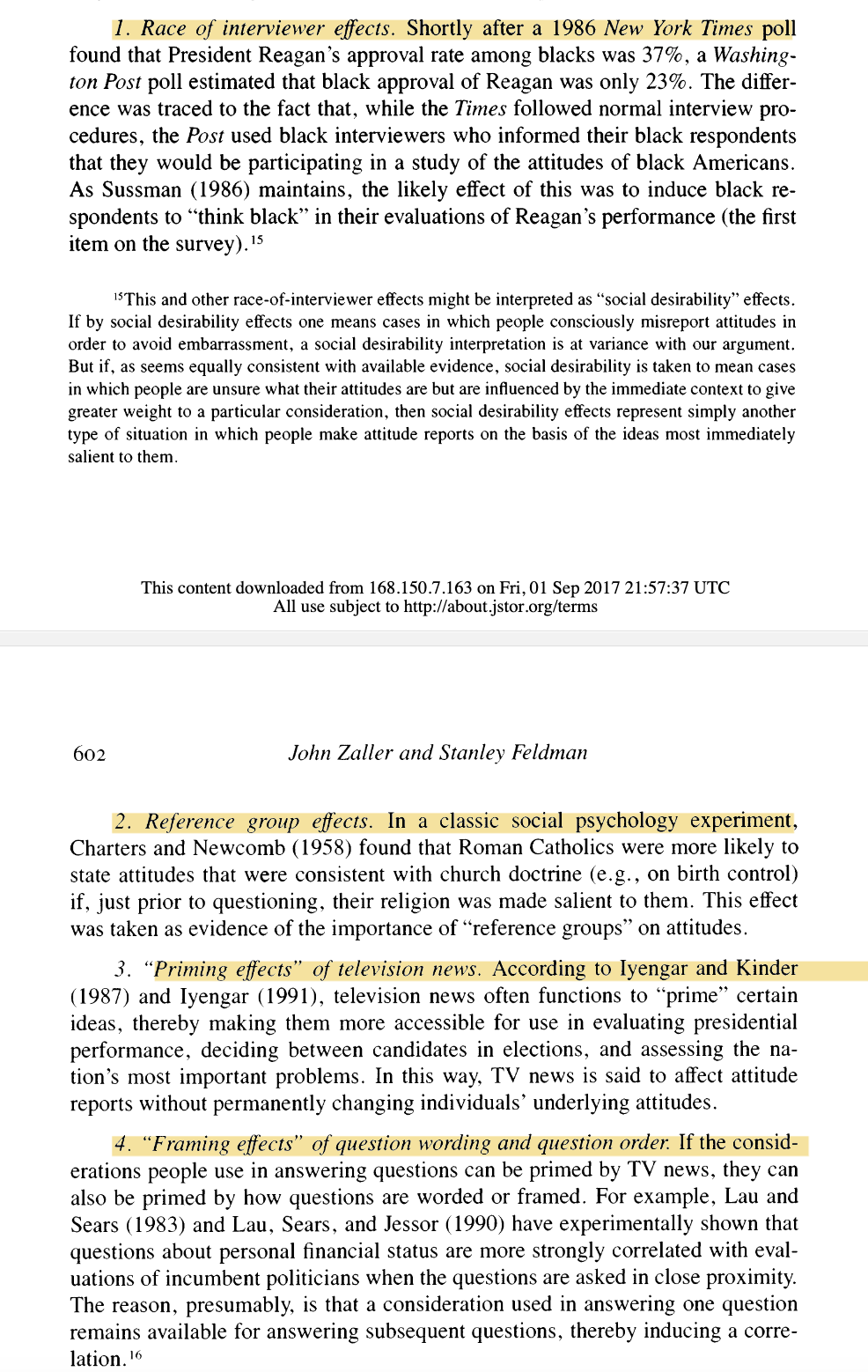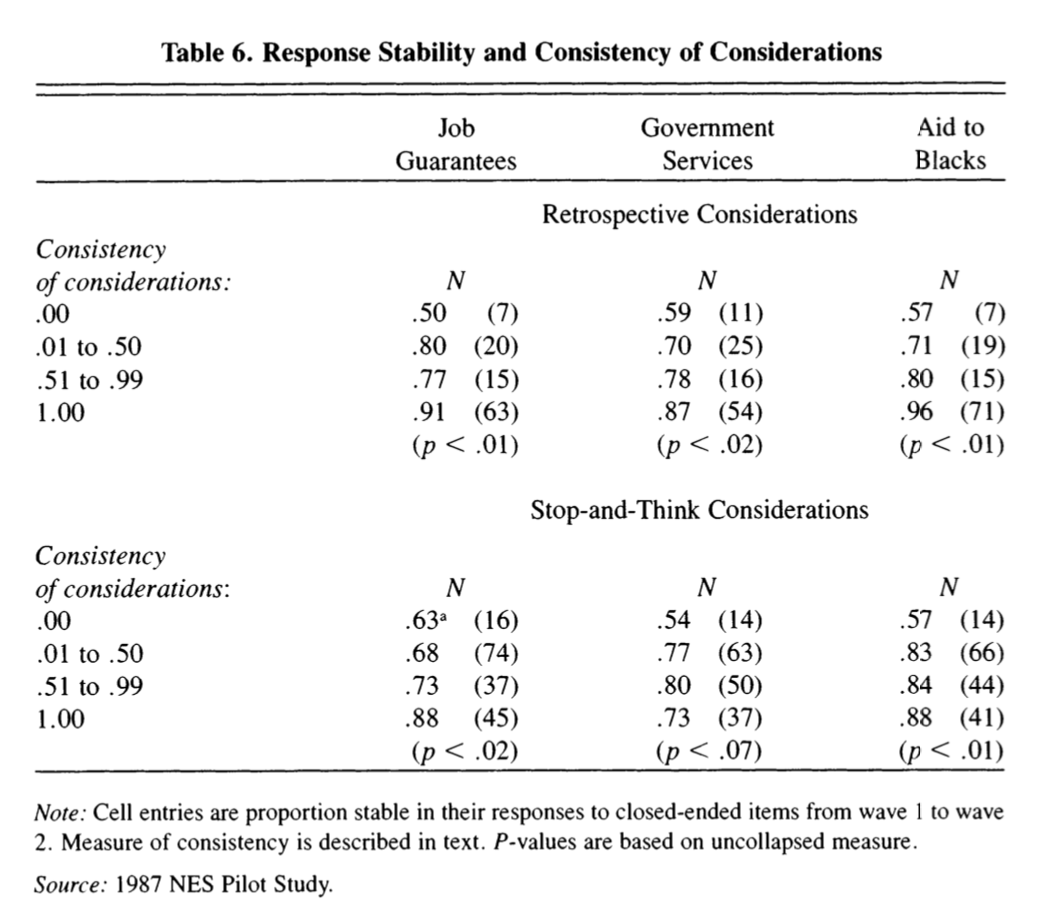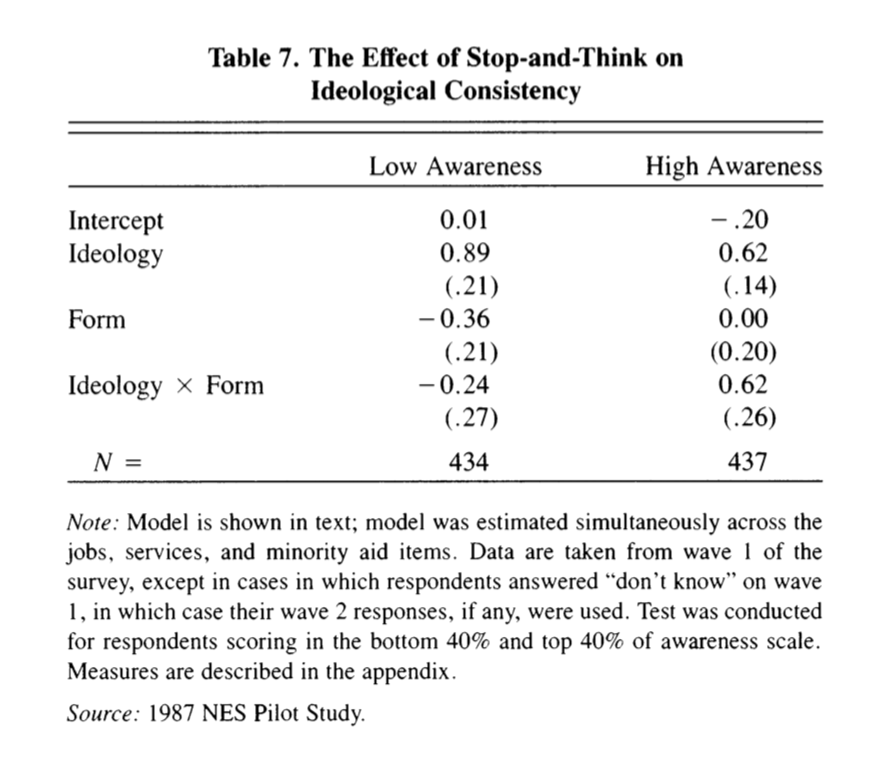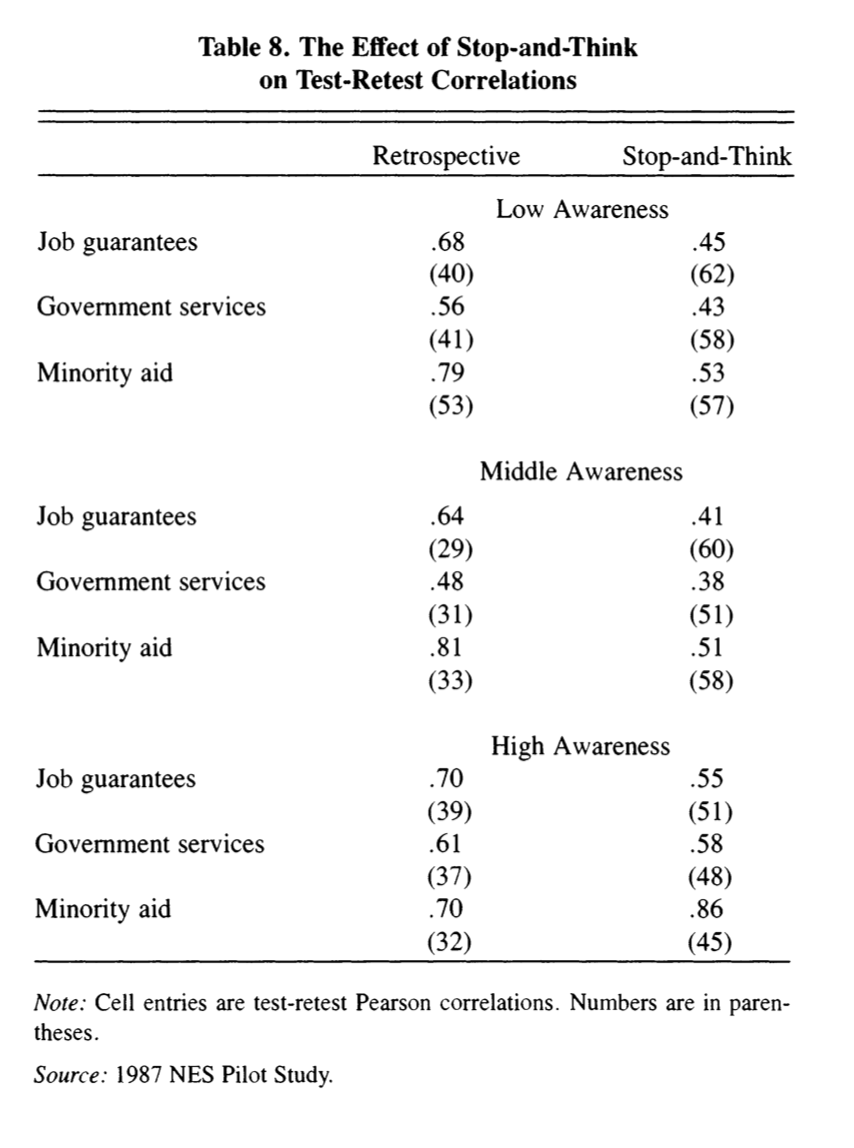POLS 1140
Models of Political Cognition
Updated Mar 9, 2025
Monday
Plan for today
Announcements
Assignment 1: October 6
Reading Reflections:
- 1st by October 15
- 2nd by November 8
- 3rd by December 6
Term Paper: October 31
Reincarnation
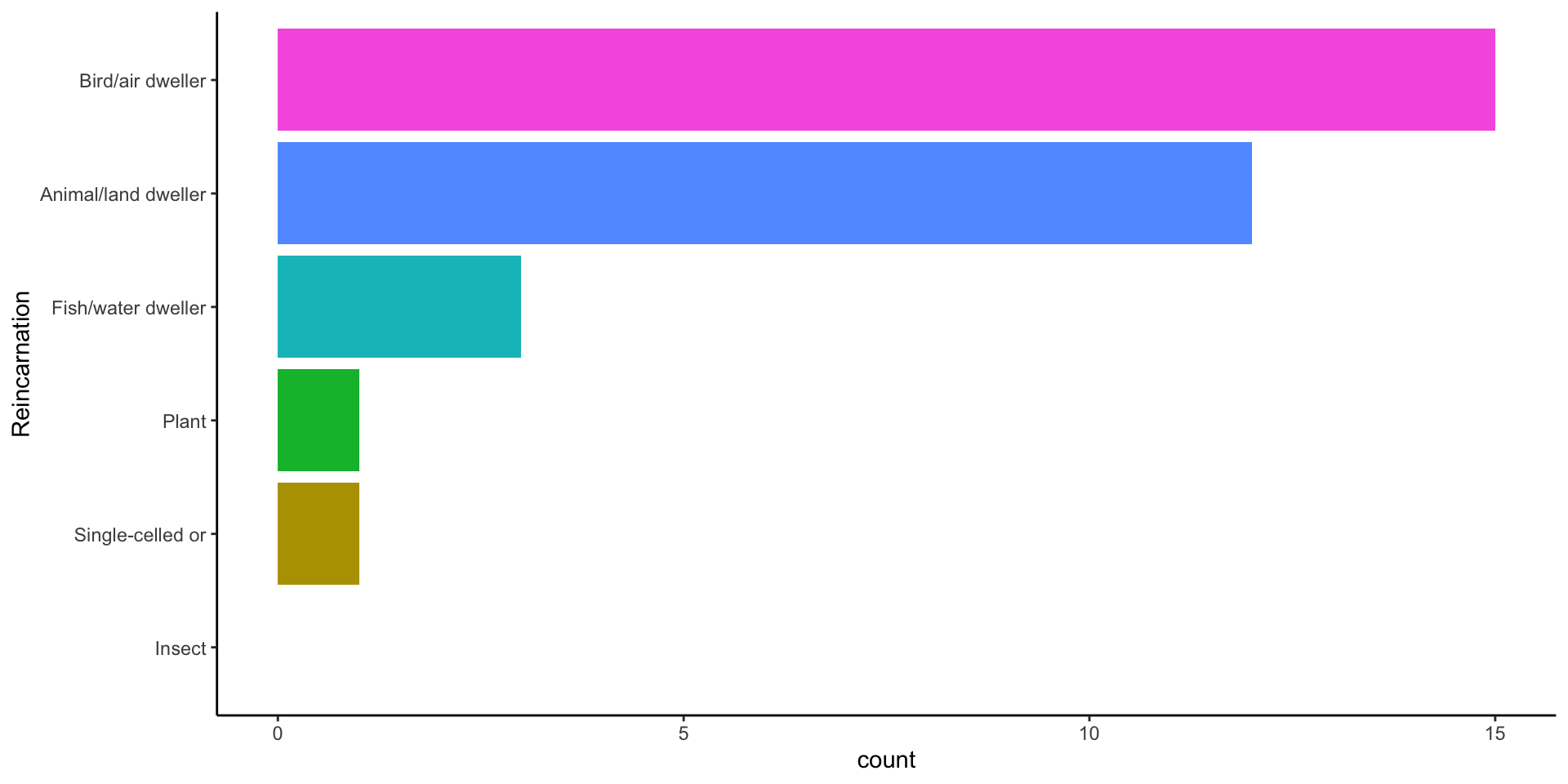
What creature and why?
Wednesday
Plan for today
Finish up discussion of J. Zaller and Feldman (1992)
Receive-Accept-Sample (J. R. Zaller 1992)
Misinformation application
Friday:
- Read Lodge and Taber (2013) Skim chapter 1 (general argument of the book), read chapter 2.
Next week: DfR Chapters 4-6.
Announcements
Assignment 1: October 6
Reading Reflections:
- 1st by October 15
- 2nd by November 8
- 3rd by December 6
Term Paper: October 31
Class Attendance Survey
Friday
Plan for today
Misinformation discussion?
Finish up Receive-Accept-Sample (J. R. Zaller 1992)
John Q. Public (Lodge and Taber 2013)
Next week: Critiques of of JQP, DfR Chapters 4-6.
Announcements
Assignment 1: October 6
Reading Reflections:
- 1st by October 15
- 2nd by November 8
- 3rd by December 6
Term Paper: October 31
Misinformation
Review
James H. Kuklinski et al. (2000): “People are misinformed when they confidently hold wrong beliefs”
Misinformation can be seen as form of motivated cognition, where directional goals dominate accuracy goals
Correcting misinformation is hard, possible for corrections to backfire, although the results are mixed
Misinformation in the news
Let’s consider some of Trump’s recent statements on immigration
First read Trump’s post on Truth Social
Skim the CNN fact check
Think about questions we might ask.

What’s the effect of Trump’s message?
How could Democrats try to counter this message?
How could we study these questions as social scientists?
Political Cognition
Overview
This is one of these topics that could be an entire course (or two)
Introduce two paradigms for thinking about political cognition
Receive-Accept-Sample (Zaller and Feldman 1992, Zaller 1992)
Dual-process models of cognition (Taber and Lodge )
Background
How to citizens make sense of a complex world?
- They don’t (Converse 1964)
They rely on cues and heuristics
- Often, but not only from elites
They construct attitudes which reflect a mix of:
Predispositions, frames, schemas
Salient considerations
Theories of the middle range
Sociological theory, if it is to advance significantly, must proceed on these interconnected planes: (1) by developing special theories from which to derive hypotheses that can be empirically investigated and (2) by evolving a progressively more general conceptual scheme that is adequate to consolidate groups of special theories - Merton (1968)
Additional Readings
Some additional readings you might consider for your reading reflections
Cues, Heuristics, Schema
Mondak (1993) “Source Cues and Policy Approval: The Cognitive Dynamics of Public Support for the Reagan Agenda.”
James H. Kuklinski and Hurley (1994) “On Hearing and Interpreting Political Messages: A Cautionary Tale of Citizen Cue-Taking.”
Kam (2005) “Who Toes the Party Line? Cues, Values, and Individual Differences.”
J. H. Kuklinski, Luskin, and Bolland (1991) “Where Is the Schema? Going Beyond the”S” Word in Political Psychology.”
Lau and Redlawsk (2001) “Advantages and Disadvantages of Cognitive Heuristics in Political Decision Making.”
Core Values, Moral Foundations
Feldman (1988) “Structure and Consistency in Public Opinion: The Role of Core Beliefs and Values.”
Evans and Neundorf (2020) “Core Political Values and the Long-Term Shaping of Partisanship.”
Weber and Federico (2013) “Moral Foundations and Heterogeneity in Ideological Preferences: Moral Foundations and Heterogeneity in Ideological Preferences.”
Hatemi, Crabtree, and Smith (2019) “Ideology Justifies Morality: Political Beliefs Predict Moral Foundations.”
Motivated Reasoning, Hot Cognition, Emotion
Taber and Lodge (2006) “Motivated Skepticism in the Evaluation of Political Beliefs.”
Coronel et al. (2012) “Remembering and Voting: Theory and Evidence from Amnesic Patients.”
Valentino et al. (2011) “Election Night’s Alright for Fighting: The Role of Emotions in Political Participation.”
Funck and Lau (2024) “A Meta‐analytic Assessment of the Effects of Emotions on Political Information Search and Decision‐making.”
Zaller and Feldman 1992
Take a few moments to review
- What’s the research question
- What’s the theoretical framework
- What’s the empirical design
- What are the results
- What are the conclusions
What’s the research question
What’s the research question
Why is there so much variation and instability in survey response?
Zaller and Feldman offer a simple theory of survey response built on three axioms that can explain both the high degrees of response instability that troubled Converse, as well as persistent response effects where simple changes to the wording or order of questions dramatically alters responses.
What’s the theoretical framework
Background:
Zaller and Feldman address research on response instability (Converse 1964) and response effects (question wording/order effects)
Argue most people don’t possess fixed attitudes
“… people are using the questionnaire to decide what their”attitudes” are (Bishop, Oldendick, and Tuchfarber 1984; Zaller 1984; Feldman 1990).” (p. 582)
- But instead formulate responses from the top of their head
What’s the theoretical framework
Three axioms:
Axiom 1: The ambivalence axiom. Most people possess opposing considerations on most issues, that is, considerations that might lead them to decide the issue either way
What’s the theoretical framework
Three axioms:
Axiom 1: The ambivalence axiom.
Axiom 2: The response axiom. Individuals answer survey questions by averaging across the considerations that happen to be salient at the moment of response, where saliency is determined by the accessibility axiom.
What’s the theoretical framework
Three axioms:
Axiom 1: The ambivalence axiom.
Axiom 2: The response axiom.
Axiom 2: The accessibility axiom. The accessibility of any given consideration depends on a stochastic sampling process, where considerations that have been recently thought about are somewhat more likely to be sampled
What’s the theoretical framework
Zaller and Feldman’s (1992) framework provide the microfoundations for the Recieve-Accept-Sample model of mass opinion developed by Zaller (1992)
Rather than read two chapters, we read one article and rely on me to flesh out the RAS model next week

Preview
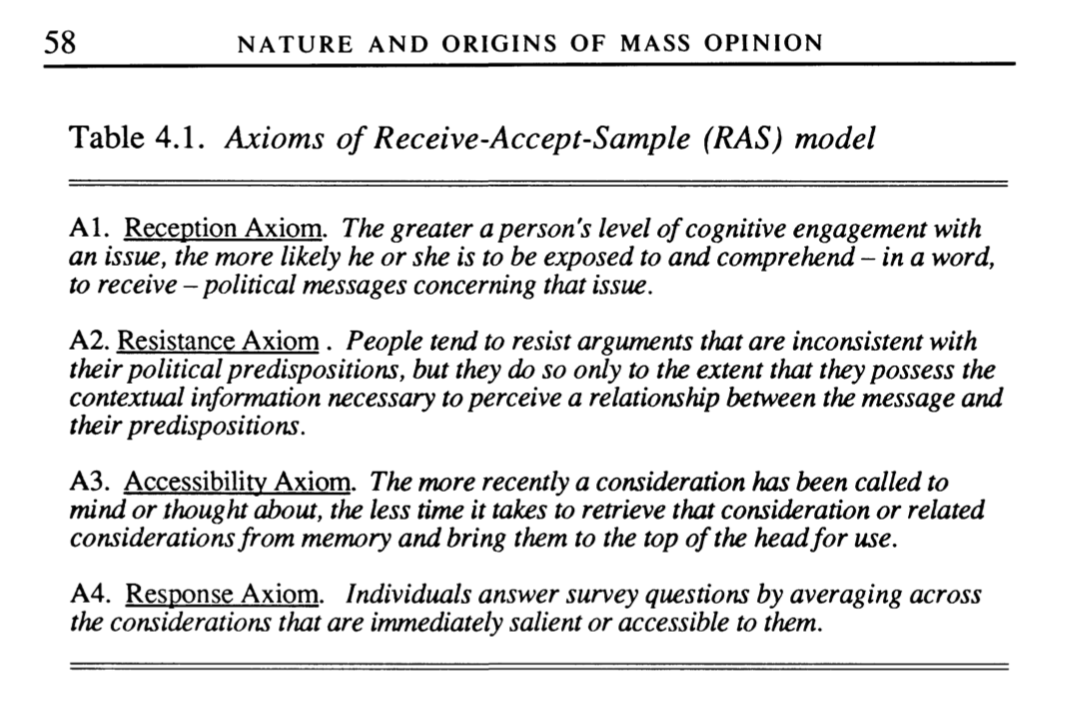
Concepts
Consideration: Any reason that might induce an individual to decide a political issue one way or another.
Political Awareness: “the extent to which an individual pays attention to politics and understands what he or she has encountered.” (Zaller 1992, p. 21) generally measured by standard PK-scales
Predispositions: stable, individual-level traits that regulate the acceptance or non-acceptance of the political communications the person receives” (Zaller 1992 p. 22)
Ambivalence: A person is ambivalent when they hold multiple, conflicting considerations
- Bipolar vs Bipartite scales
What’s the empirical design
Two-wave panel data from the 1987 Pilot Study of the NES
Close-ended items on three policy items on job guarantees, government services, and aid to Blacks
Paired with
- Retrospective Probes (Memory Dump)
- Prospective (Stop and Think)
Responses coded a number of ways (p. 589) to capture “ambivalence”
Retrospective Probes:
- Retrospective: ” designed to find out what exactly was on people’s minds at the moment of response”
Still thinking about the question you just answered, I’d like you to tell me what ideas came to mind as you were answering that question. Exactly what things went through your mind. (Any others?)
Prospective Probes
- Stop and Think: “designed to induce people to search their memories more carefully than they ordinarily would for pertinent considerations.”
Before telling me how you feel about this, could you tell me what kinds of things come to mind when you think about government making sure that every person has a good standard of living? (Any others?)
Now, what comes to mind when you think about letting each person get ahead on their own? (Any others?)
What are the results
What are the results
Model purports to explain a lot

What are the results
Let’s condense these into the following claims:
People often hold conflicting considerations on issues
Total considerations increases with political knowledge
People form responses from considerations at the top of their head
More consistent considerations = More stable responses
Political awareness moderates the effect of survey form
People often hold conflicting considerations on issues
viewof q1 = Inputs.form([
Inputs.textarea({
label: "Axioms",
placeholder: "Ambivalence, Response, Accessibility",
width: "500"
}),
Inputs.textarea({
label: "Evidence",
placeholder: "Table? Page? Figure?",
width: "500"
})
])People often hold conflicting considerations on issues
Total considerations increases with political knowledge
viewof q2 = Inputs.form([
Inputs.textarea({
label: "Axioms",
placeholder: "Ambivalence, Response, Accessibility",
width: "500"
}),
Inputs.textarea({
label: "Evidence",
placeholder: "Table? Page? Figure?",
width: "500"
})
])Total considerations increases with political knowledge

People form responses from considerations at the top of their head
viewof q3 = Inputs.form([
Inputs.textarea({
label: "Axioms",
placeholder: "Ambivalence, Response, Accessibility",
width: "500"
}),
Inputs.textarea({
label: "Evidence",
placeholder: "Table? Page? Figure?",
width: "500"
})
])People form responses from considerations at the top of their head
More consistent considerations = More stable responses
viewof q4 = Inputs.form([
Inputs.textarea({
label: "Axioms",
placeholder: "Ambivalence, Response, Accessibility",
width: "500"
}),
Inputs.textarea({
label: "Evidence",
placeholder: "Table? Page? Figure?",
width: "500"
})
])More consistent considerations = More stable responses
Political awareness moderates the effect of survey form
viewof q5 = Inputs.form([
Inputs.textarea({
label: "Axioms",
placeholder: "Ambivalence, Response, Accessibility",
width: "500"
}),
Inputs.textarea({
label: "Evidence",
placeholder: "Table? Page? Figure?",
width: "500"
})
])Political awareness moderates the effect of survey form
Summary of the results
Unstable attitudes reflect underlying ambivalence
Describe attitudes as the result of a probabilistic search reflecting:
- Effects of ideas recently made salient
- Effects of thought on attitude reports
What are the conclusions
As we’ll see, the analyses here provide the foundation for the RAS model of mass opinion
Elite driven
Individuals in context
But perhaps ignores the role of groups and issues
Receive-Accept-Sample
What’s the theoretical framework
- Zaller and Feldman’s (1992) framework provide the microfoundations for the Receive-Accept-Sample model of mass opinion developed by Zaller (1992)

Four Axioms of RAS

The RAS Model:
Opinion statements, are the outcome of a process in which:
People receive new information
Decide whether to accept it based on predispotions, prior considerations, contextual knowledge
Sample at the moment of answering questions by averaging across considerations
Pr(Liberal)=LL+C
Implications of the Model
People are often ambivalent on issues
Ambivalence is a function of political awareness
Response effects reflect changes in the accessibility of different considerations
Persuasion depends on both reception and acceptance
The flow of information matters (one-sided vs two-sided)
People are often ambivalent on issues
Politics is complex
People are often aware of arguments for and against particular issues
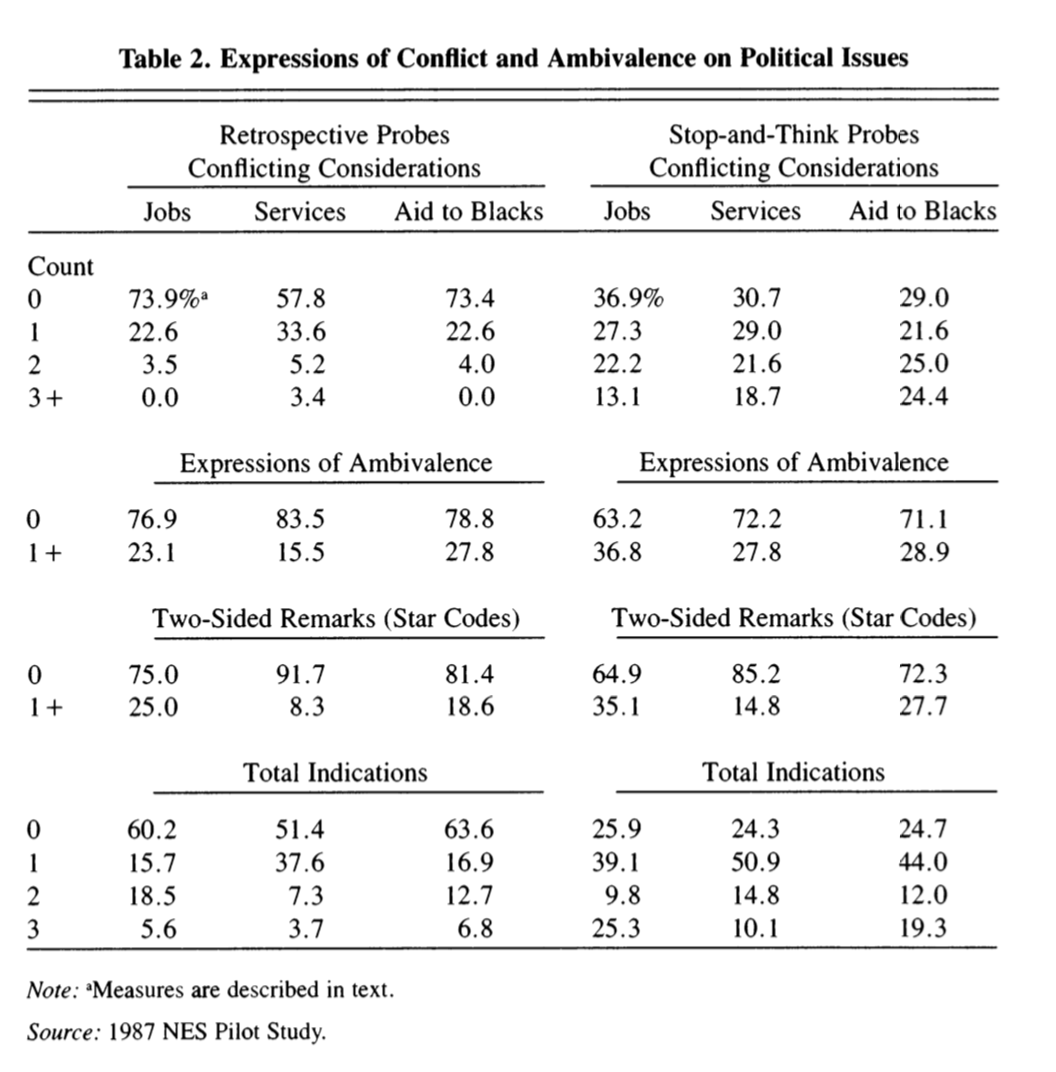
Ambivalence is a function of political awareness
The politically aware encounter more information but accept less
The political unaware encounter less, but may reject more inconsistently
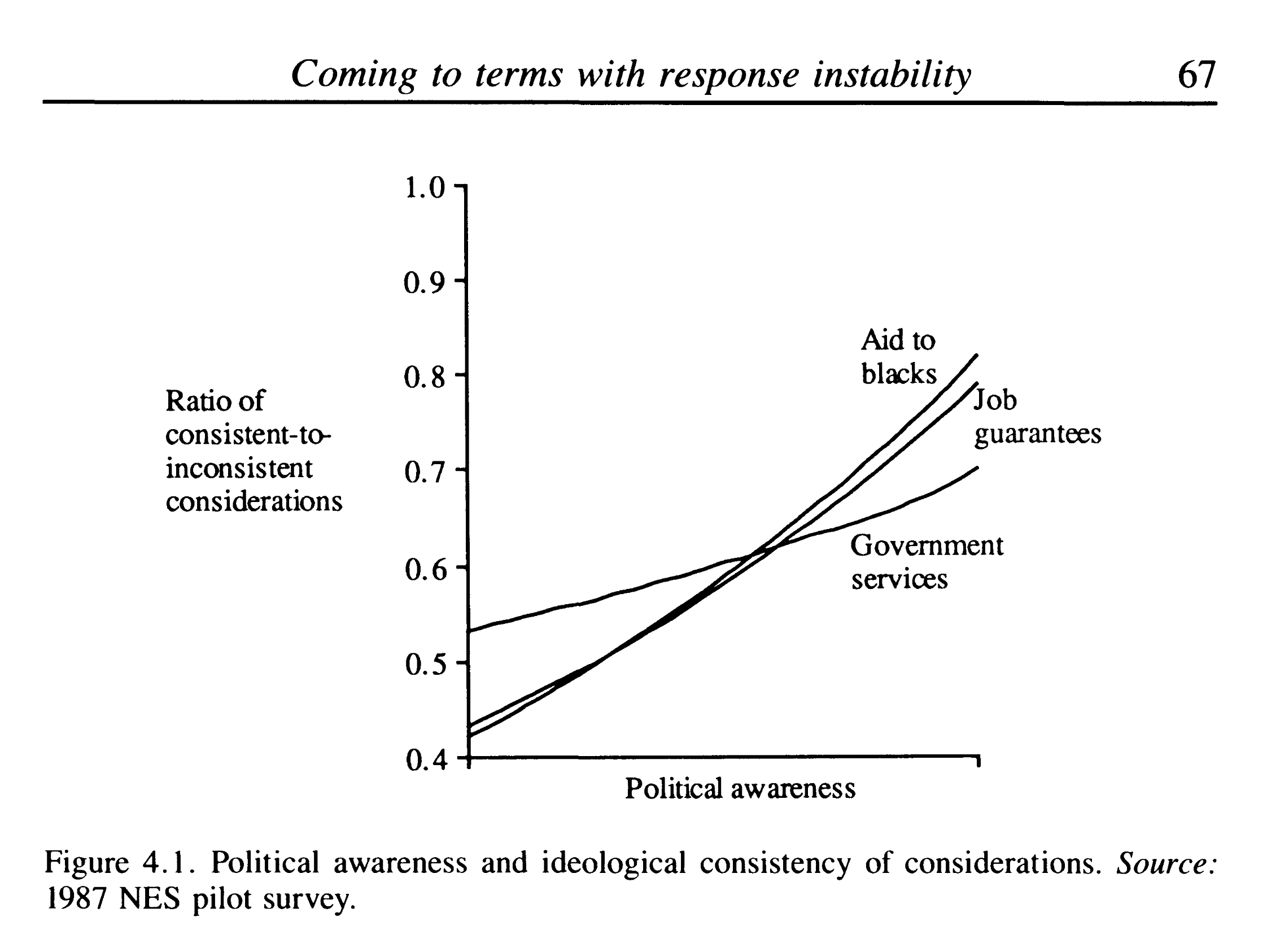
Response effects
The accessibility axiom is consistent with “response effects” like:
Race of interviewer effects
Question order effects
Question wording effects
Each alter the saliency or accessibility of different considerations
Persuasion depends on both reception and acceptance
Pr(Change)=Pr(Reception)×Pr(Acceptance|Reception)

Hard vs Easy Learning

The flow of information matters
RAS is a largely a top-down model, where people draw considerations from elite discourse.
RAS predicts change when the flow of information changes
The nature of changes should differ based
- Characteristics of individuals (political sophistication)
- The nature of information flow (one-sided vs two-sided)
The flow of information matters
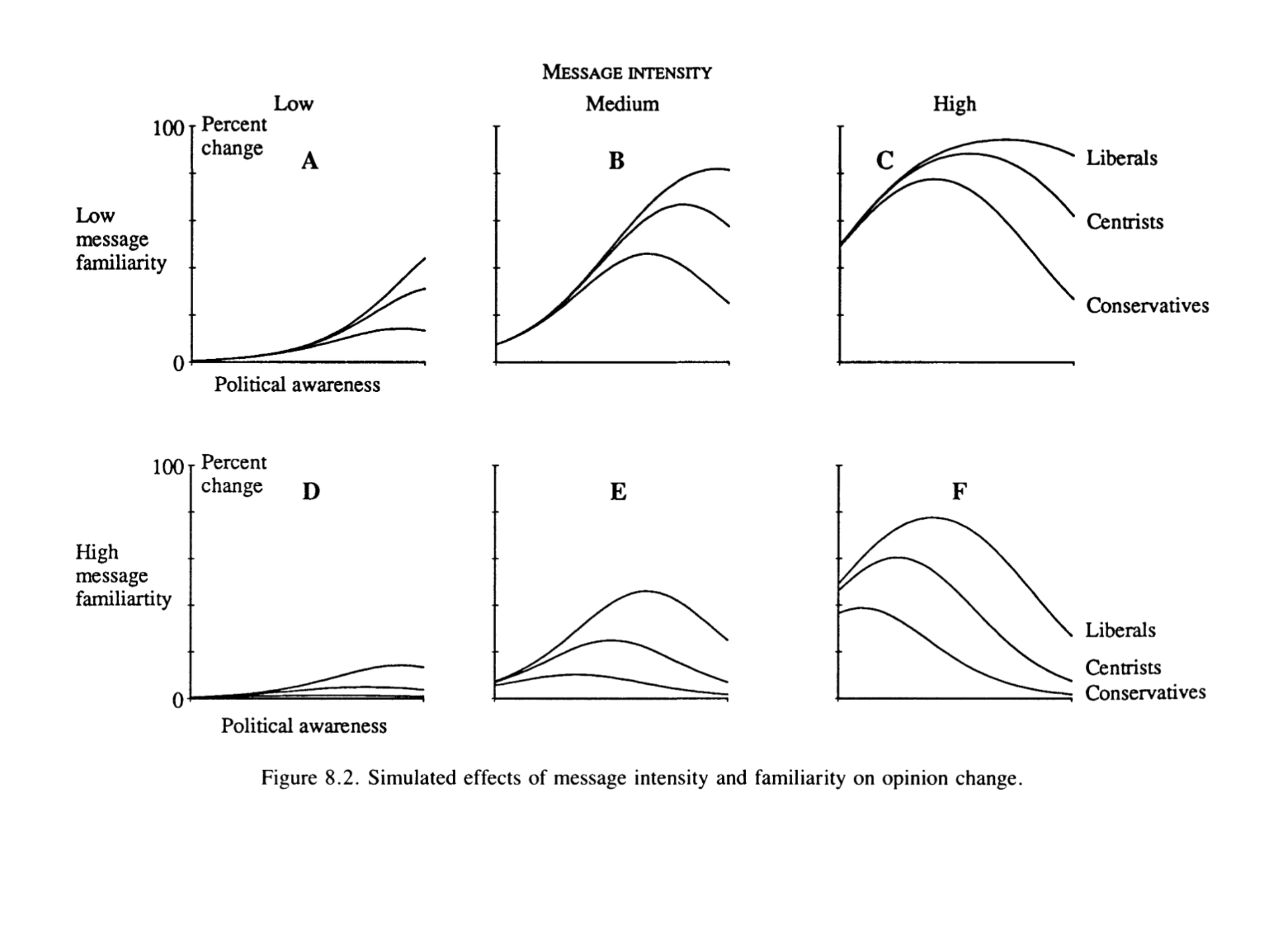
Changes in the Information Flow
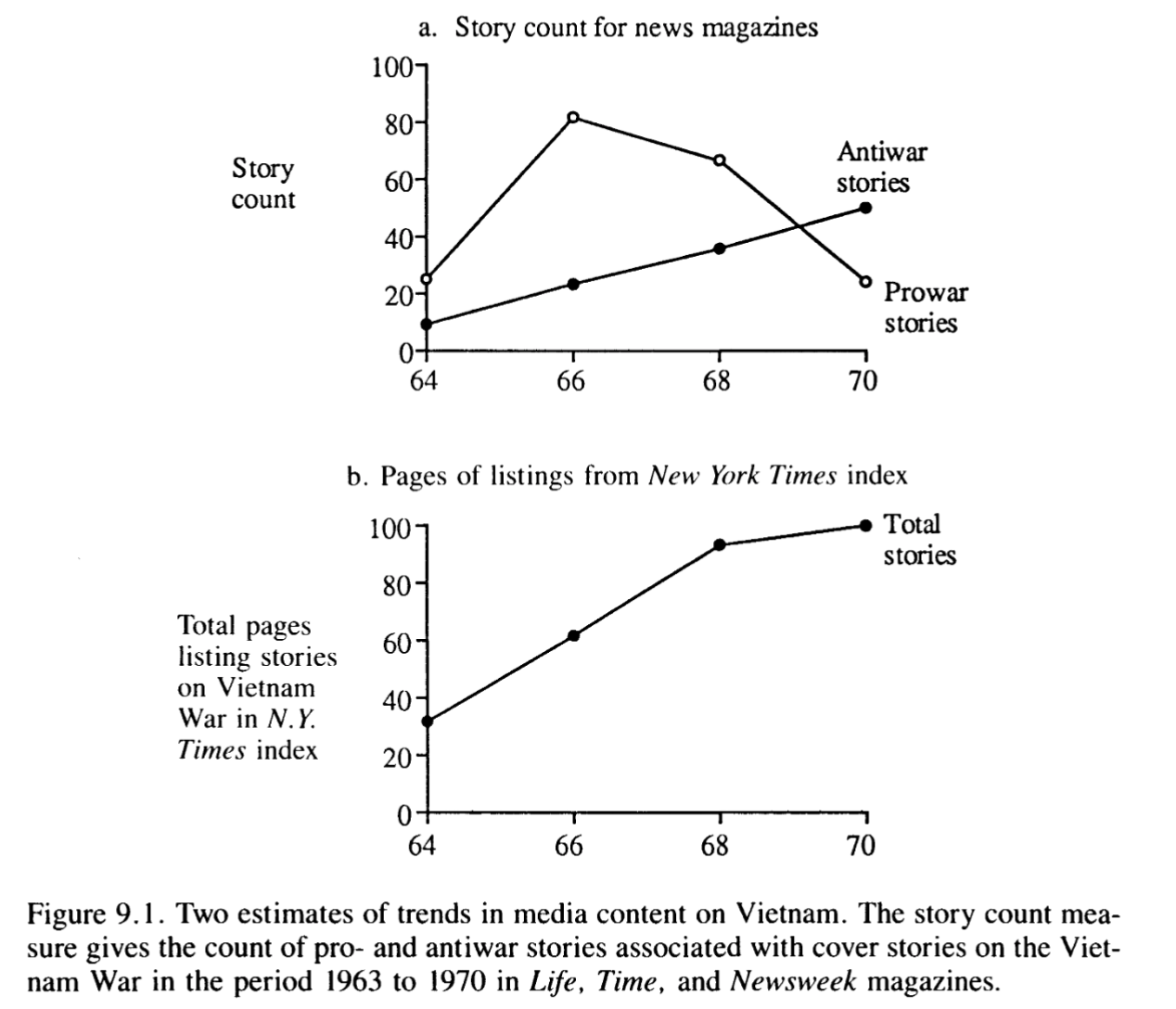
Lead to Changes in Attitudes about Vietnam War
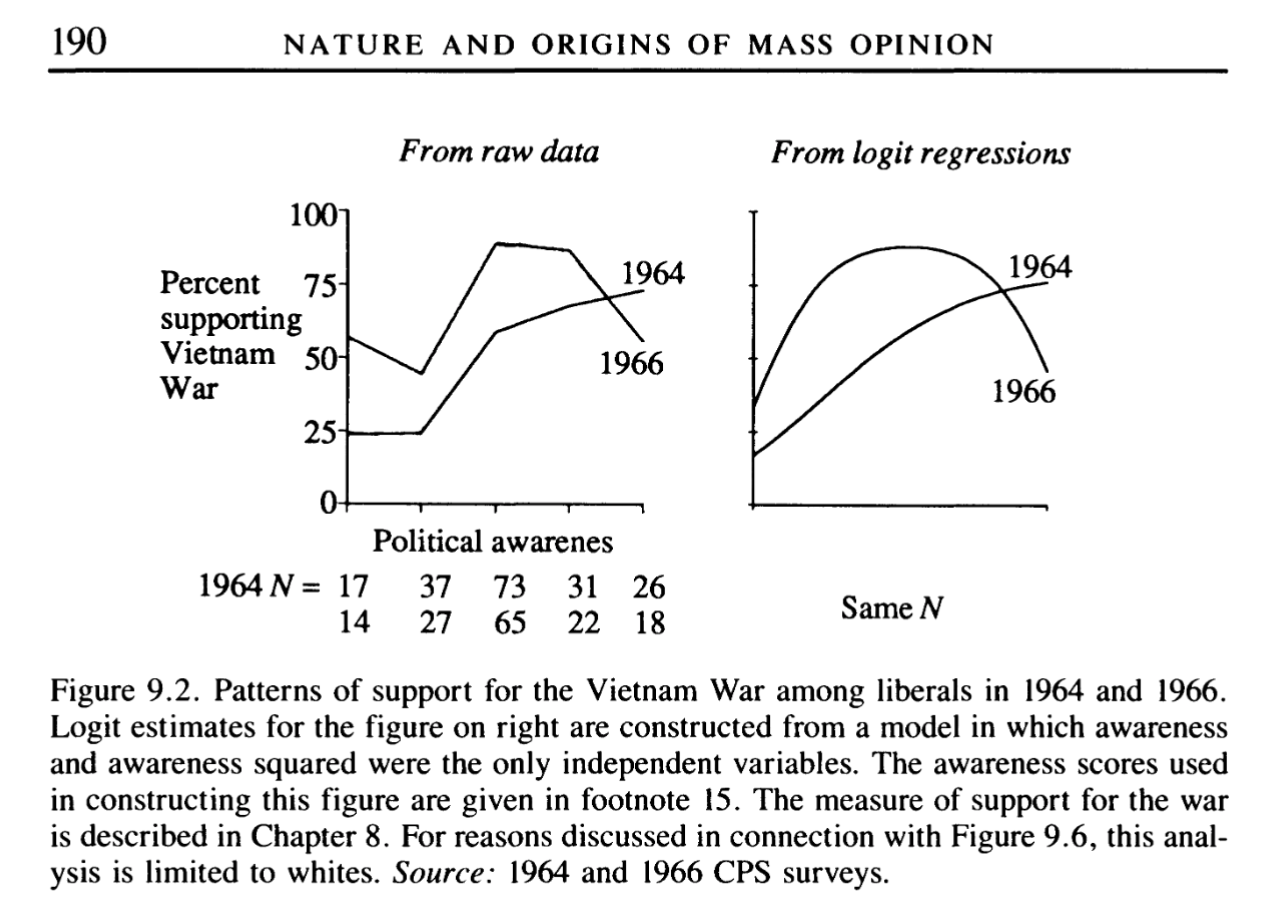
Summary: The Nature and Origins of Mass Opinion
Zaller (1992) articulate’s the Receive-Accept-Sample model of mass opinion
- People receive information from the world
- Decide whether to accept this information into their store of considerations
- Form attitudes by sampling from their available considerations
Summary: The Nature and Origins of Mass Opinion
The RAS model implies that
People are often ambivalent on issues
- Possess competing considerations on issues
Ambivalence is a function of political awareness
- ↑ political awareness → ambivalence ↓
Response effects reflect changes in the accessibility of different considerations
Persuasion depends on both reception and acceptance
- Political awareness increases reception, but decreases acceptance
The flow of information matters
- One sided vs Two sided
Studying Misinformation
Misinformation in the news
Let’s consider some of Trump’s recent statements on immigration
First read Trump’s post on Truth Social
Skim the CNN fact check
Think about questions we might ask.

What’s the effect of Trump’s message?
How could Democrats try to counter this message?
How could we study these questions as social scientists?
What’s the effect of Trump’s post?
Consider a simple survey experiment, in which we randomly assign half of respondents to read the post, and half to read nothing (or to read a non-political post).
Now we could estimate an Average Treatment Effect by comparing the difference in means on some outcome (survey question) between those who read the post and those who didn’t
- What are some outcomes we could measure?
- What would we expect to find?
- What are the strengths and limitations of this design?
- How could we change/improve this simple design?
What are some outcomes we could measure?
- Misinformation about immigration
- Support for Trump/Harris
- Trust in media/government
- Others?
What are our expectations?
Overall, we might expect that reading the post
Increases Misinformation about immigration
Decreases Support for Harris
Decreases Trust in media/government
But we might also expect that these effects vary by:
- Partisanship
- Political interest/sophistication
- Race and ethnicity
- Other factors?
Strengths and limitations
Strengths:
Random assignment creates credible counterfactual comparisons
The only source of difference between these groups should be the fact that one read the post and the other did not
Weaknesses:
The effects of Trump’s post likely vary on the likelihood of receiving it
Are we spreading misinformation?
Note
Experimental designs are prized for their internal validity – we’re confident that any differences we observe are due to treatment and not confounding factors
But experimental designs generally lack ecological validity. How do we know the effects we observe study, are what we would actually see in the world?
How would we extend/modify this design
- Add treatment conditions
- Three-arm design: Control Post, Post plus Correction?
- Four arm design:
- Incorporate opportunities for choice and self selection Testa et al. (2020)
- ATE is weighted average of treatment effects among those likely and unlikely to receive the treatment
Dual Process Models of Cognition
Alternatives to RAS
- RAS is a “useful” model
- It appears to explain a lot with relatively few assumptions
- RAS is a “simple” model
- Lot’s of mechanisms left unexplained
Dual Process Models of Cognition
Dual process models distinguish between systems of cognition that are fast and slow
- System 1: Fast, Automatic, sub/pre-conscious, parallel, long-term memory
- System 2: Slow, Deliberate, conscious, serial, working memory

The Driving Analogy

Taber and Lodge (2013)
Taber and Lodge (2013) use this dual process framework to argue citizens
- Rationalizing, not rational
- Influences by subtle/implicit cues
- Rely on a Likeability Heuristic
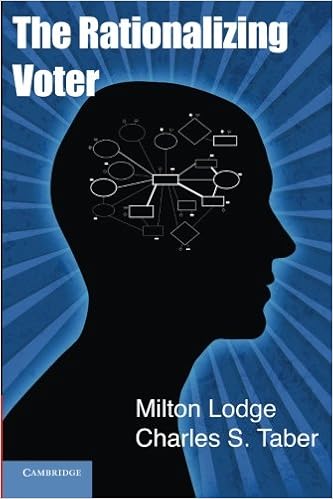
Taber and Lodge (2013)
The fundamental assumption driving our model is that both affective and cognitive reactions to external and internal events are triggered unconsciously, followed spontaneously by the spreading of activation through associative pathways which link thoughts to feelings, so that very early events, even those that remain invisible to conscious awareness, set the direction for all subsequent processing (p. 18)
The Model

Key Concepts
Hot Cognition
Affect Priming
Spreading Activation
Affect Contagion
Motivated Bias
Affect Transfer
Argument Construction
Construction of Evaluations
Rationalization
Attitude Updating
Belief Updating
Key Concepts
Hot Cognition
Affect Priming
Spreading Activation
Affect Contagion
Motivated Bias
Affect Transfer
Argument Construction
Construction of Evaluations
Rationalization
Attitude Updating
Belief Updating
Seven Postulates (p.34)
Information processing is
Automaticity:
Hot cognition:
Somatic embodiment:
Primacy of affect
Online updating
Affect transfer
Affect contagion
Hypotheses
Hot cognition: all political objects have positive or negative valence
Automaticity: attitudes and behavior can be influenced by information processes that occur outside conscious awareness
Affect transfer: affective states and primes can influence current thoughts
Affect contagion: affective states and primes can influence information retrieval
Motivated reasoning prior affect will bias attention and processing of information toward those prior beliefs
Hot Cognition
Automatic feelings associated with an event or object
Positive or negative
Preceed and shape more “rational” deliberative thoughts
Who you got

Todorov et al. 2005
inferences of competence based solely on facial appearance predicted the outcomes of U.S. congressional elections better than chance
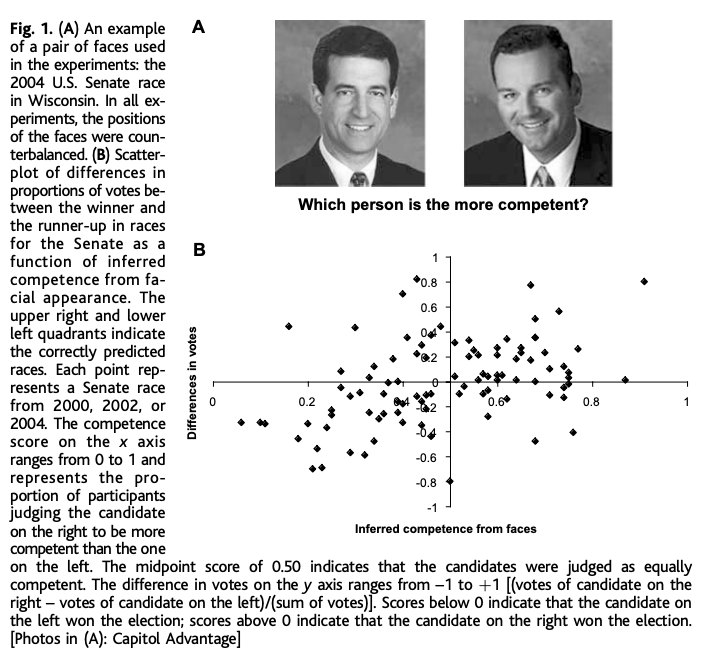
Spreading Activation
- What comes to mind when you think of former president Barack Obama?
Spreading Activation
Illustration of hypothetical, white, Republican voter’s beliefs about Obama
When think of Obama, these additional connections are activated
The stronger the connections, more likely they are to reach consciousness
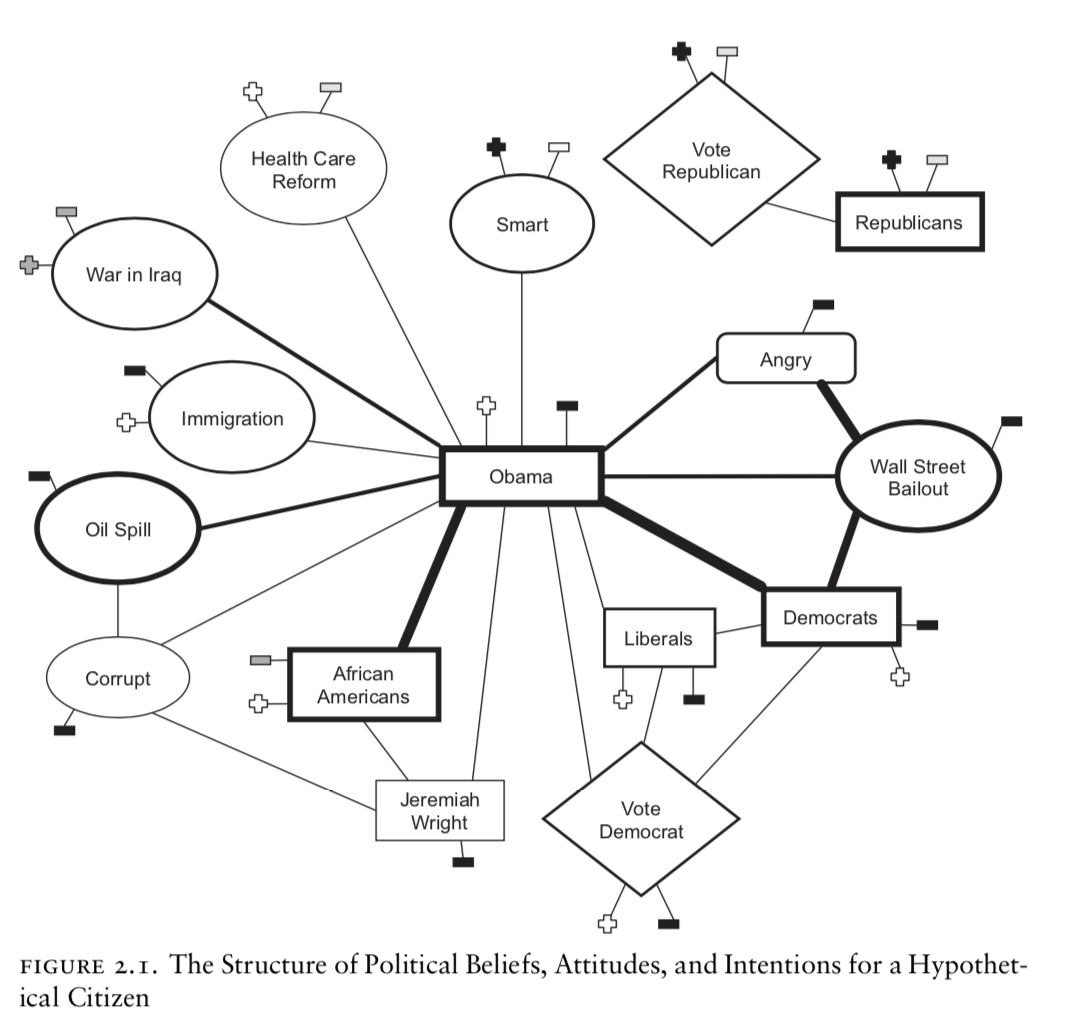
Affect Transfer, Priming and Contagion

Affect Contagion
An affective contagion effect, such that an unnoticed positive prime promotes positive thoughts and inhibits negative thoughts, while an unnoticed negative prime promotes negative and inhibits positive thoughts. (p. 136)
Affect Contagion
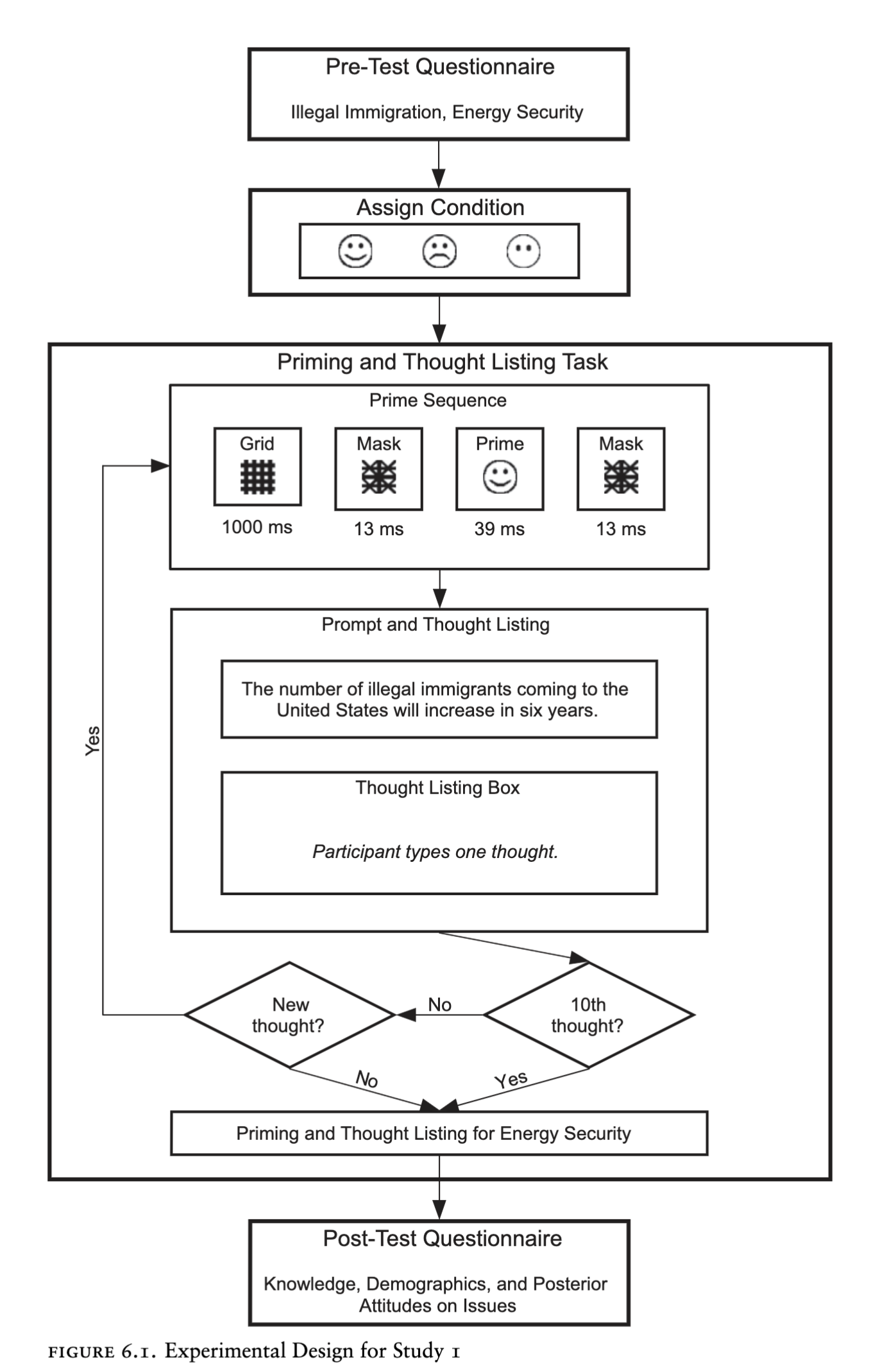
Affect Contagion
Simple cartoon faces flashed outside the conscious awareness of experimental subjects significantly and consistently altered their thoughts and considerations on a political issue, with effects greater in size to those of prior attitudes on the issue (p. 142)
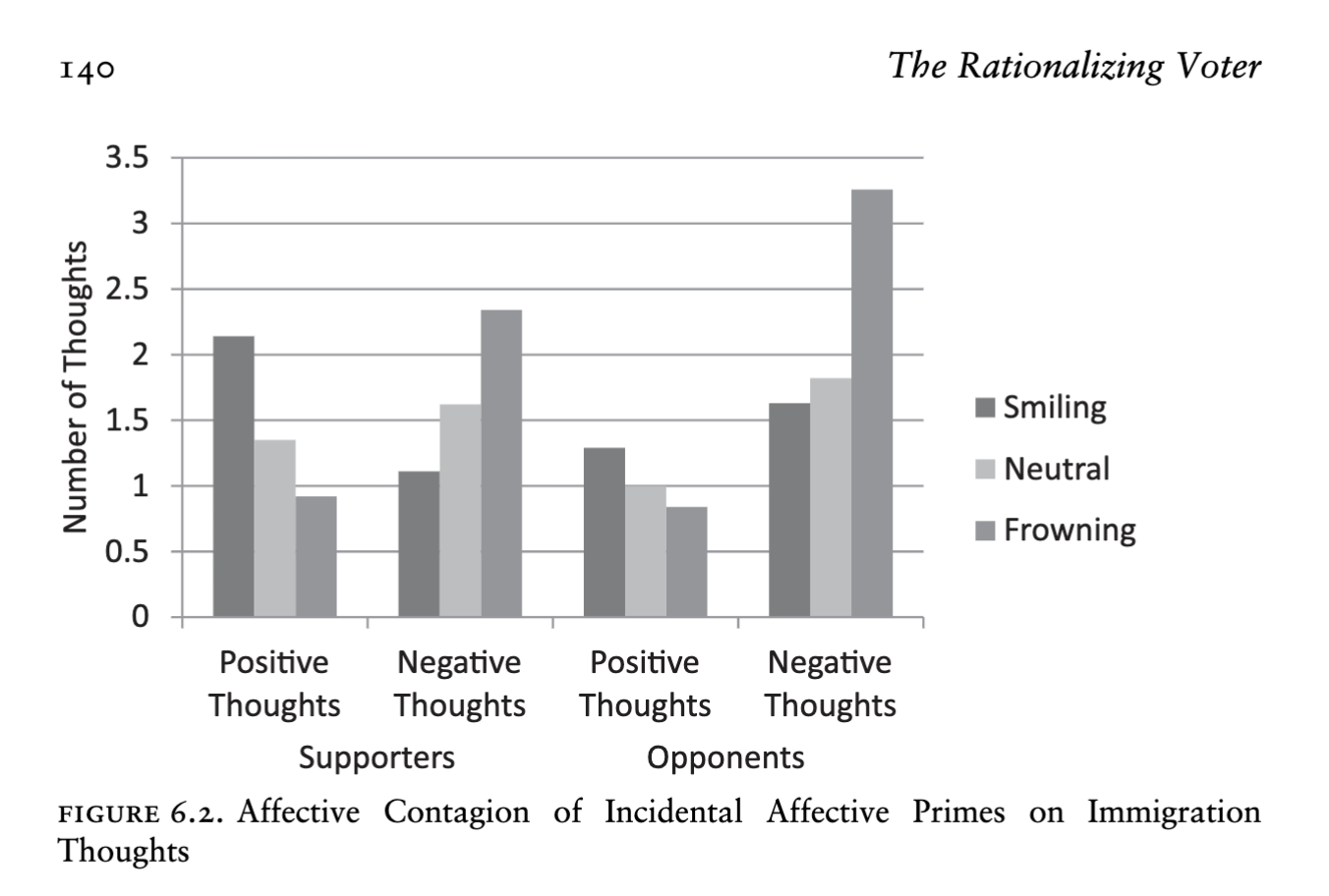
Motivated Reasoning
Ask participants to rate the strength of equivalent arguments
People with strong priors, greater knowledge, rate congruent arguments as stronger
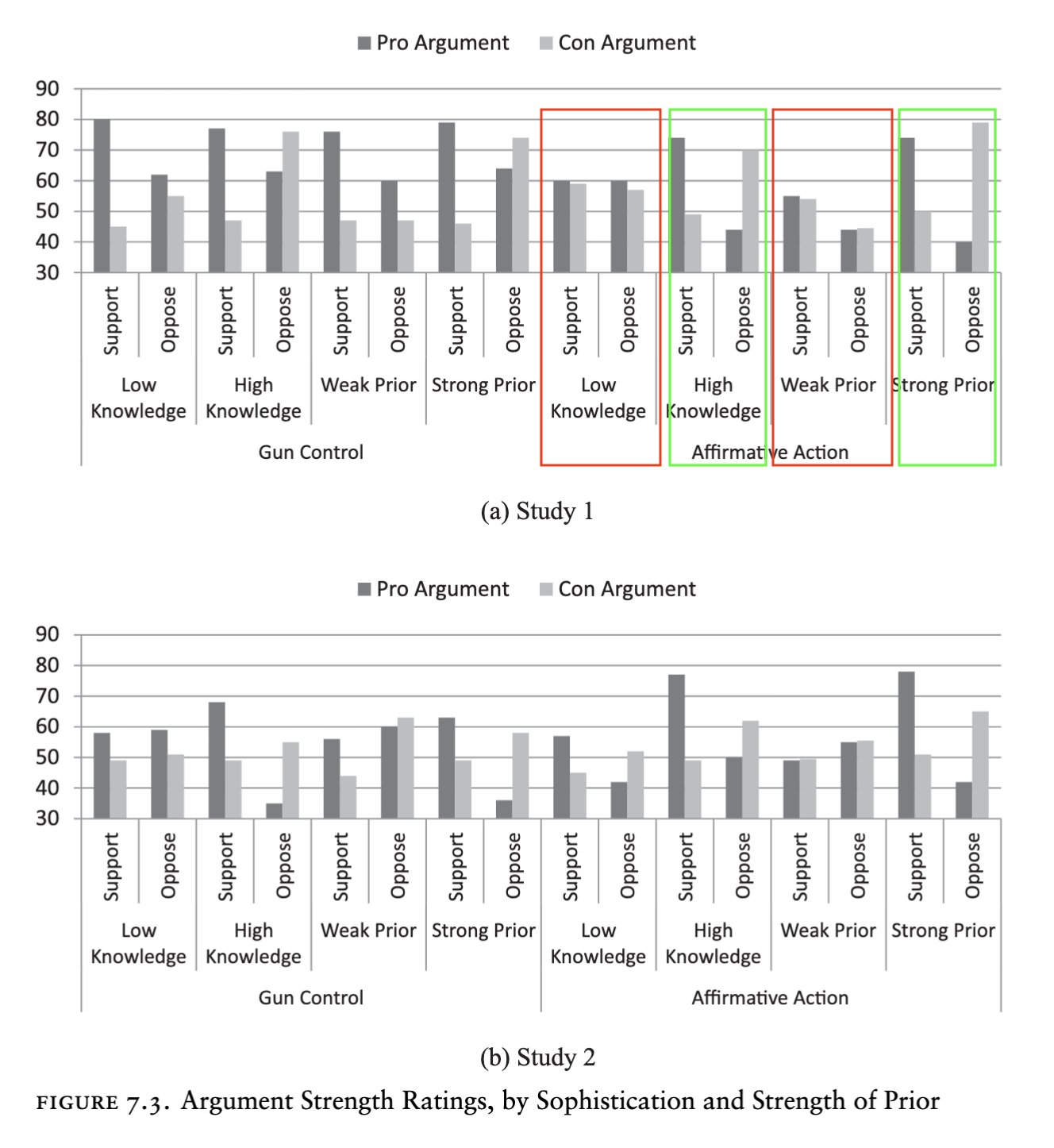
Taber and Lodge (2013) - The Rationalizing Voter
Dual process model of cognition
System 1: Fast, automatic, outside consciousness (How they actually make many decisions)
System 2: Slow, deliberative, conscious thought (How we think citizens should make political decisions)
Affect proceeds and shapes attitudes and behavior
Seven Postulates (p.34)
Information processing is
Automaticity: Priming studies
Hot cognition: “Thin slice” cadidate evaulations
Somatic embodiment: Iowa gambling experiment
Primacy of affect fMRI studies showing affect proceeds concious thought
Online updating Candidate evaluation and recall studies
Affect transfer “Sunny day” studies
Affect contagion Long run consequences of hot cognition and affect transfer
Critiques
Implicit vs Explicit attitudes
Are priming effects short lived?
- Are they real?
External (and internal validity)
Positive/Negative affect vs Discrete Emotions
References

POLS 1140
